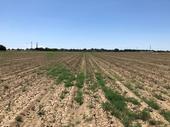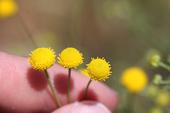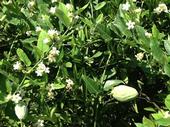- Author: Brad Hanson

I was out in the field today and drove by this fallow field and did two things. First, since I'm a weed scientist, I stopped to take a photo of this weedy streak. Second, because I know the site manager and know he hates weeds, I called to give him a hard time about "missing one".
Any guesses on what happened here? It might help if I told you I'm facing south and this area often has a prevailing wind out of the northwest during winter and early spring. Another clue would be the construction site to my back with minimally managed weeds. One more clue might be the fence behind me still loaded up with Russian thistle carcasses and debris.
Here's a link to the
- Author: Chris McDonald

Stinknet (Oncosiphon piluliferum, aka globe chamomile) is a winter annual that is spreading across Southern California and poses threats to wildlands, rangelands and agricultural areas. Stinknet was first found in western Riverside County in the early 1980's. It slowly spread to surrounding areas and by the late 1990's it was found in over a half dozen locations in Riverside and San Diego Counties. By this time, it had also spread to Phoenix. While stinknet has not been one of the fastest weeds to spread across the state (stinkwort, Dittrichia graveolens, is definitely a top contender for that spot, see here) it is now currently found in...
- Author: Ben Faber
- Re-posted by: Gale Perez

From the Topics in the Subtropics blog :: March 4, 2020
* * * * * *
So I've gotten a few calls lately about this vine with a big green pod that is growing in lemon trees. What is done with it and how do you get rid of it?
Araujia sericifera, cruel vine, moth plant, bladderflower is an escaped ornamental that has become an invasive weed in California. Yes, a pretty vine brought into the garden – “poor man's stephanotis” - and it's gotten out...
- Re-posted by: Gale Perez

From the Western IPM Center e-newsletter for Feb. 2020
New Risk Assessments Just Posted for Invasive Weeds
The U.S. Department of Agriculture's Animal and Plant Health Inspection Service recently posted Weed Risk Assessments for a dozen new weeds of concern.
Eleven of the 12 are already documented in the West.
The purpose of the assessments is to evaluate the...
- Author: Marie Jasieniuk
- Posted by: Gale Perez
The global horticultural trade in ornamental plants is well known to be a primary source of non-native invasive plant introductions worldwide. In the United States, non-native species make up as much as 80% of the ornamental nursery stock and account for most nursery revenue. Although only a small percentage of these species escape cultivation and become invasive, the large number and diversity cultivated, especially in California, results in ornamental plants contributing to more than half of the invasive weeds currently damaging California's wildlands and remnant natural areas in urban landscapes.
The majority of ornamental plants are purchased and grown by the public. Thus, educating consumers to make informed choices towards...


